In memory of the Centenary of the commencement of WWI and the Gallipoli campaign Warbirds Online celebrates some very famous Australian Flying Corps (AFC) aircraft and today we recognize the efforts of those who fought in the AFC Bristol Fighters, F.2Bs or “ Brisfit” as it was known.
The Bristol F.2B was first flown on 25 October 1916 and was a development of an earlier F.2A (of which only 52 were built).
The Bristol F 2B was designed to operate as a two-seat fighter armed with forward firing Vickers and rear facing Lewis machine guns, however fragmentation bombs could also be fitted.
Initial operational service deliveries were commenced in April 1917 and over 5,329 Bristol Fighters were built during the 1914-18 war, and production continued into 1919.
- Bristol F2B fighters No1 Sqn. AFC
- Bristol F2B Fighter & crew
The Bristol initially failed spectacularly on its first RFC mission on the Western Front with the loss of 5 of the six F.2As being shot down. However pilots and tactics rapidly developed and the Brisfit was from then on a potent and respected aircraft. Although a 2 seater, the aircraft, was best flown like a single seater with the pilot firing the forward gun in the same way as most single seaters and the observer in the rear seat using his single or twin Lewis guns to protect if the aircraft was attacked from the rear.
The AFC utilized a total of 66 Bristol Fighters in No’s 1, 3 and 7 (Training Sqn UK). The aircraft of No 1 Sqn were the most numerous with a total of 49 aircraft believed utilized. In particular one very famous Brisfit, B.1229 of No1 Sqn AFC (Also known as 67 Sqn RFC at one stage) serving in the Middle East. B1229 was a “presentation” aircraft meaning that it was procured for 2,700 Pounds from a donation by the Macintyre Kavuga Estate of NSW and was the 11th such aircraft NSW donors had provided. The aircraft carried the inscription “N.S.W. No. 11, The Macintyre Kavuga Estate “under the rear cockpit.
- Capt. Sir Ross Macpherson Smith
- Bristol Fighter F2B Sn.B1146
This aircraft was at one stage flown by Captain Ross Smith, later Sir Ross Smith, K.B.E., M.C. and Bar, D.F.C. and two Bars, A.F.C. Smith scored 11 of his 12 enemy victories in this machine in the Middle East between Sept 1917 and October 1918. Smith served in No1 Squadron AFC and whilst there flew as Lawrence of Arabia’s pilot on several occasions in the F.2B. He (also a Gallipoli veteran) survived the war and took part in several record flights (For which he and his brother Keith were knighted) however he was killed in crash in the UK in April 1922.
Fortunately color photos exist of AFC No1 Sqn F.2B’s and even one of Smith in front of an F.2B although not B1229, as seen in this article.
Smith’s 12 victories in AFC No1 Sqn were:
B1229 was also flown by several other Australians and is said to have a total record of 20 Victories. Pilots flying this aircraft are said to have achieved 17 decorations.
The mystery surrounding the eventual fate of B1229 is unresolved. In a circa 1930 book “Aces and Kings” it states the aircraft was to be in the collection of the Australian War Memorial, however there is no record of it since. Another F.2B B1284 was also brought back to Australia post war with two German aircraft but all of these machines have also disappeared over time. It was not unknown for the AWM and the RAAF to dispose of surplus historic material.
At least 7 and possibly 9 Australian Aces flew the Bristol Fighter and it was a very effective type and highly regarded by the AFC and the opposing German pilots.
- Bristol F.2B at Duxford
- Bristol F.2B propeller
- Bristol F.2B at Shuttleworth
- Bristol F.2B at Shuttleworth
Most No 1 Squadron Bristol Fighters were equipped with 4 blade propellers as they worked better than the two blade units in the desert environment. All of the operational aircraft of 1 and 3 Sqns flew with the Rolls Royce Falcon, an aero engine developed in 1915. It was a smaller version of the Rolls-Royce Eagle a liquid cooled V-12 of 867 cu in (14.2 L) capacity. The versions used were the Mk1 and Mk111.
No 7 Training Sqn based at Leighterton, Gloucestershire, UK utilized 11 F.2Bs mostly powered by the 200hp Sunbeam Arab engine.
The Bristol Fighter was also fitted with 2 alternate engines as supplies of the Rolls Royce Falcon were scarce:
- 200 hp (150 kW) Sunbeam Arab piston engine
- 200 hp (150 kW) Hispano-Suiza engine
- Bristol F.2B at Hendon
- Bristol F.2B interior
- Bristol F.2B interior tail
- Bristol replica – 1988
Australia surrendered all its Bristol Fighters at wars end and none joined the RAAF in Australia although a number came to Australia as the civil Bristol Tourer passenger aircraft operated by Western Australia Airways. Two replica flying Bristol Tourers were constructed for film work in Australia in the 1980s and both survive – one at Oakey Queensland, restored as a F.2B, painted to represent one of the aircraft operated by the Army’s No. 1 Squadron in Palestine – C4623 and one still in Bristol Tourer state in a Western Australian Museum.
Recently a F.2B flying replica has been imported into Australia from New Zealand and it was announced that it will operate at Caboolture Queensland with the colors of AFC B1229.
A number of original and replica Bristol Fighters fly globally as well as a few in museums including:
- The Shuttleworth Collection contains one airworthy F.2B Fighter, identity D8096
- The Canada Aviation and Space Museum, in Rockcliffe, Ontario, D-7889
- The New Zealand film director Peter Jackson owns D-8084, which flies from the Hood Aerodrome in Masterton, New Zealand. The Aviation Heritage Centre in Omaka, N.Z holds a second original fuselage (although this may have been rebuilt into a replica recently).
On Static display:
- A Bristol F.2B Fighter preserved at the Imperial War Museum Duxford
Substantially original aircraft are on static display at the:
- Royal Air Force Museum London
- Imperial War Museum Duxford
- Museo del Aire, Madrid
- VAF, Old Kingsbury, Texas
- Musée Royal de l’Armée, Brussels
- Polish Aviation Museum, Krakow
In addition, there is a large portion of wing structure of F.2B in storage at the RAF Museum London.
Engineers at Rolls-Royce, Airbus and GKN Aerospace-Filton have also built a full-scale replica F.2B in celebration of 100 years of aircraft manufacture at Filton Bristol, where the original fighters were designed and built.
So the Bristol Fighter was a great success for Australia and served us well in WWI and has an enviable record.
© John Parker 2015
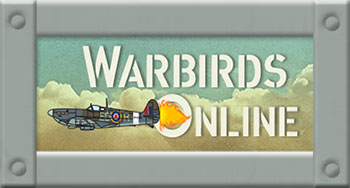
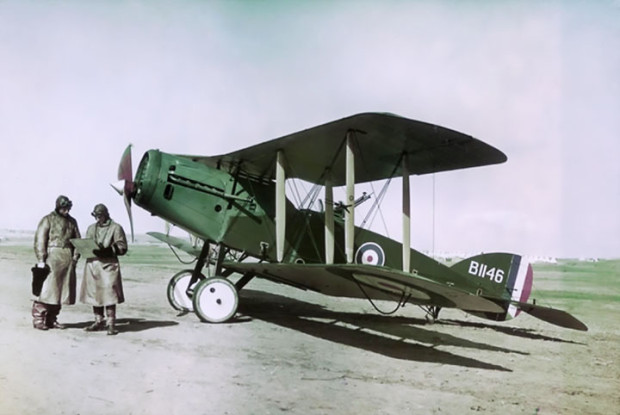
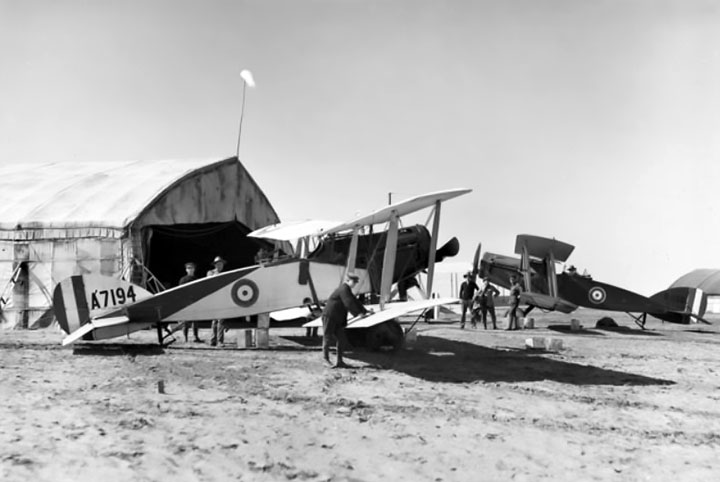
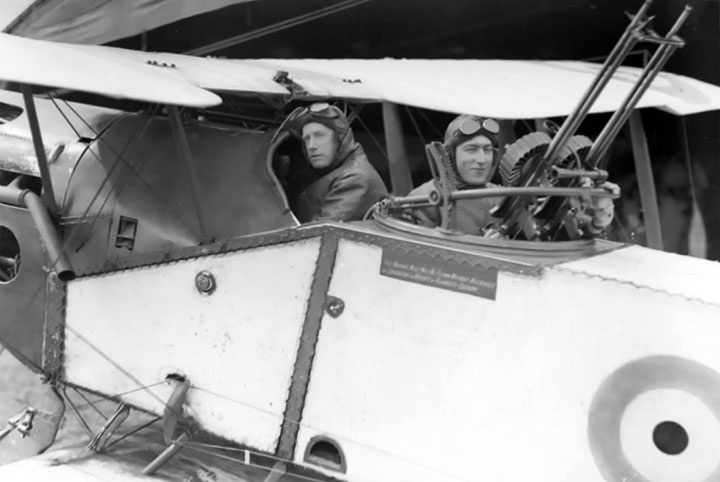
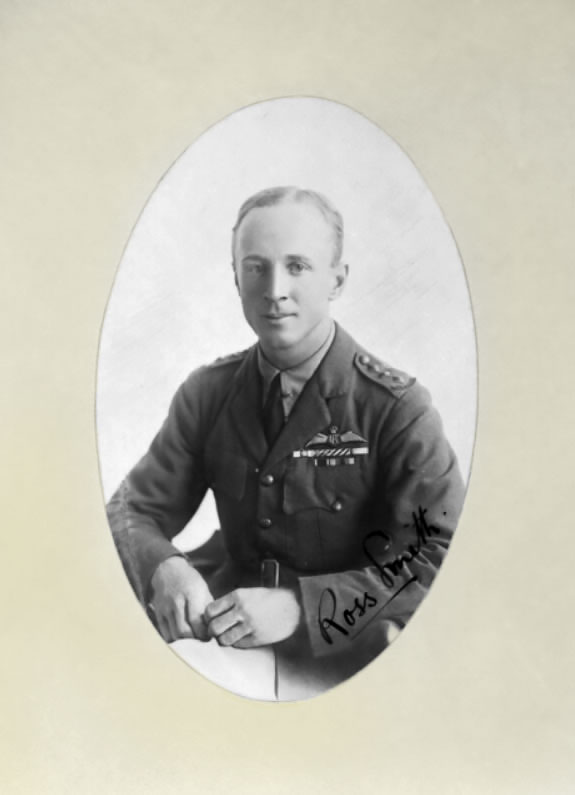
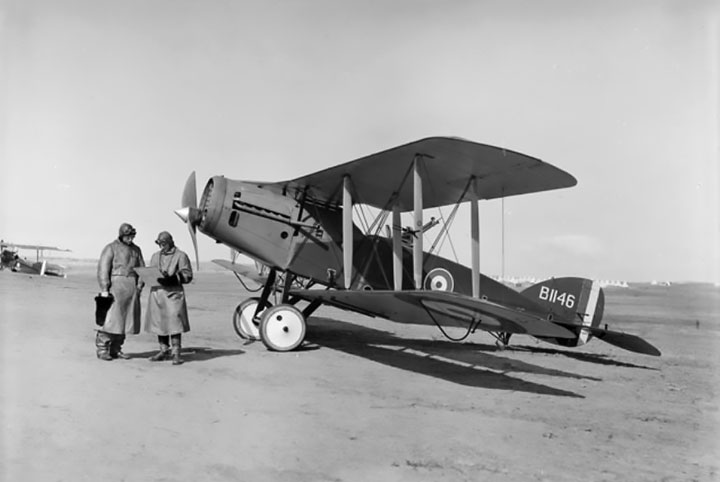
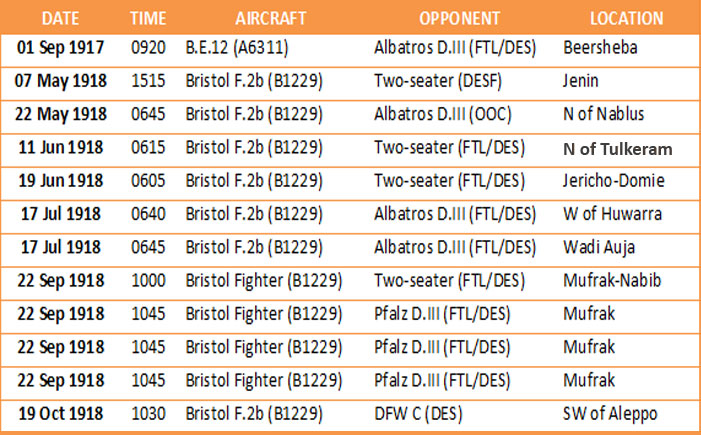
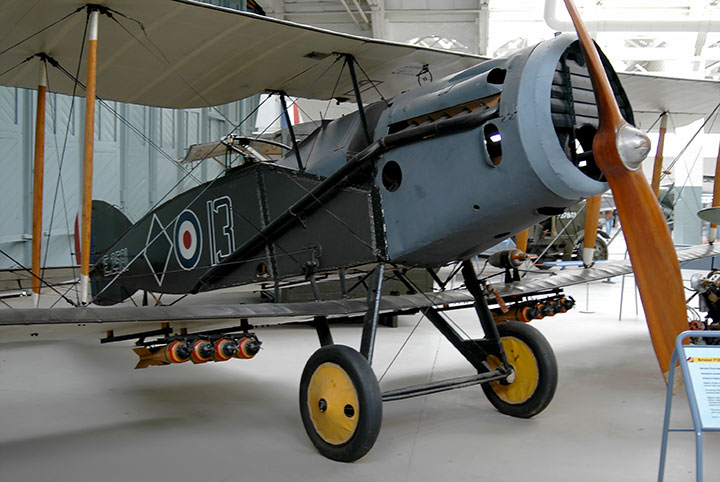
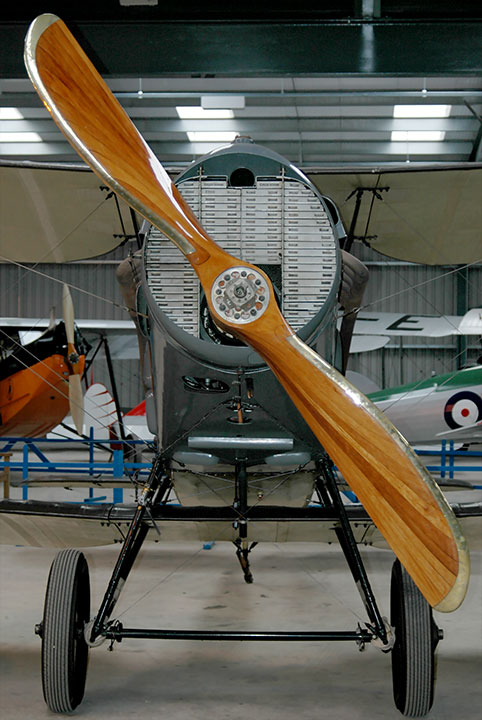
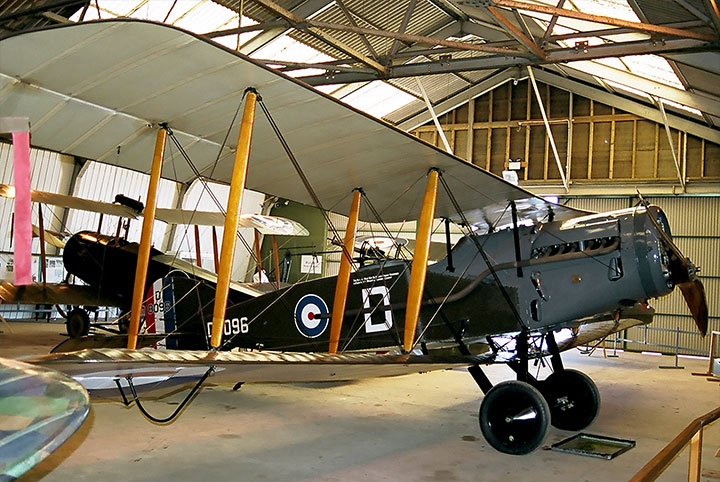
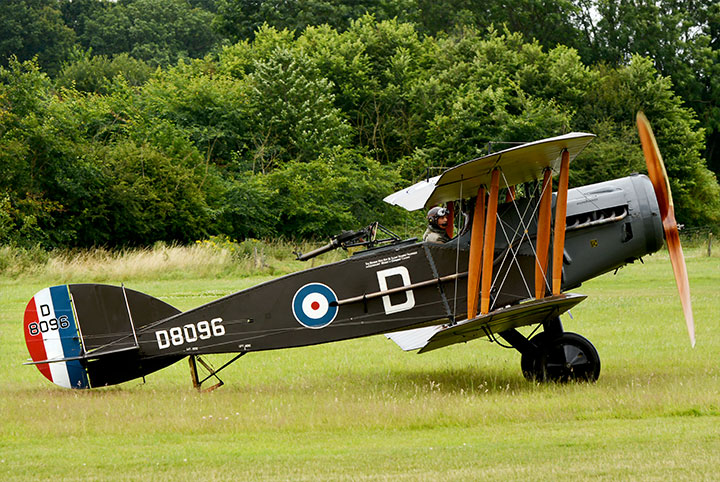
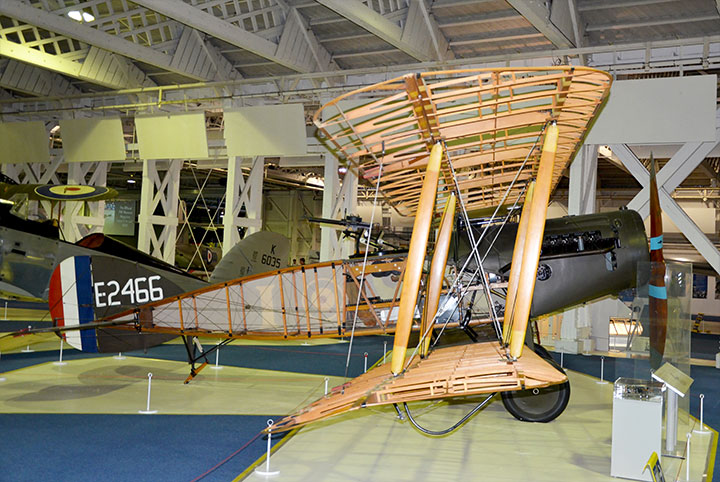
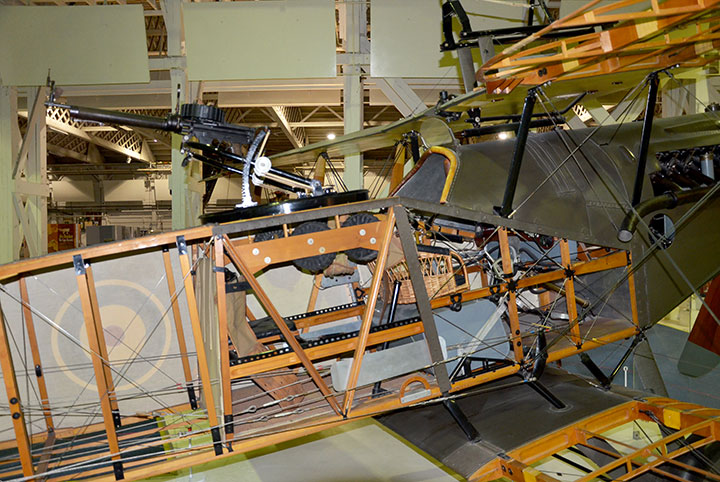
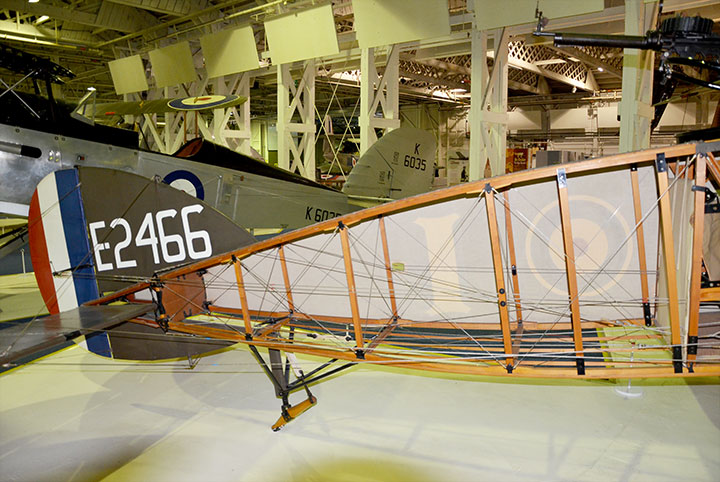
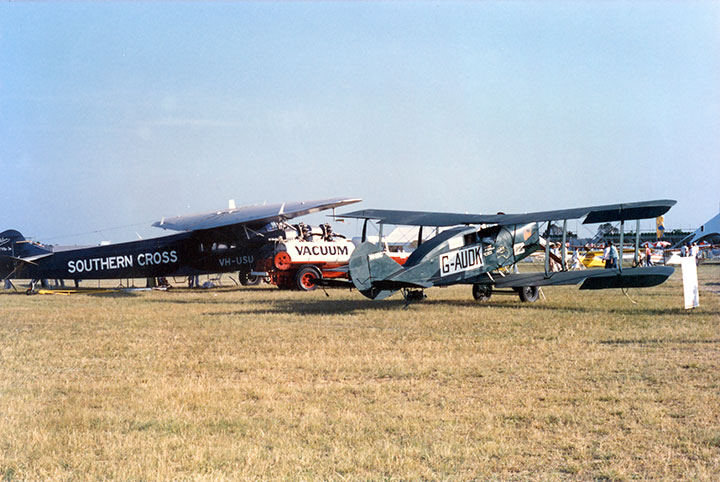
Hello John,
I enjoyed your article, which I discovered while researching a photograph I’m preparing for sale. It depicts a WW1-vintage biplane, which I hoped was photographed flying in South Australia (well, it is in a contemporary frame by a SA framer!). It looks like a Bristol F2, but I don’t know if that makes a nonsense of my SA dream. I notice you mention that the F2B came to Australia only as a civilian aircraft for Western Australian Airways. Then I discovered the following image https://www.awm.gov.au/collection/C50694 which indicates that a military F2B was definitely in Adelaide in October 1920. Coupled with the fact that the client’s name written on the verso by the framer is Butler, and that one Harry Butler was advertising joyflights (presumably in the Red Devil) in the Adelaide papers that month (see The Register, Wednesday 13 October, page 2), suddenly I get very excited. Do you have any thoughts? – spanners in the works, or lifelines – it doesn’t bother me as long as I can sort it out one way or another. I’ll email you the image if you are interested in having a look. Regards, Mick
Hi Mick
Thank you that’s all very interesting information. The Red Devil was not a Bristol FB2 – it was a Bristol monoplane. The Red Devil is in a Museum in Minlaton SA. Several FB2’s were imported into Australia as Museum pieces and all were destroyed post war. I will do some research for you and get back to you if you forward me a copy of the image. Your photo will be very interesting to research.
Kind regards
John
Hello John,
I was involved in the project where “Engineers at Rolls-Royce, Airbus and GKN Aerospace-Filton have also built a full-scale replica F.2B in celebration of 100 years of aircraft manufacture at Filton Bristol, where the original fighters were designed and built.” My company was contacted by Rolls-Royce engineers in 2009 concerning plans I had developed for a flying replica of the Bristol F.2b. I was pleased to donate a set to the project. Because the airplane was intended to be a static display, the team elected not to use my fuselage as designed. I specialize in between the wars replicas now. Fairey IIIF and Fox, Hawker Demon, Boeing F4B/P-12 and others.
Best regards,
Tom
Hi Thomas
Thanks for getting in touch and sharing this with us.
Kind regards
John
Hi all,
I am wondering if it is known who in No. 3 Squadron AFC flew the Bristol Fighters? My great uncle served in that squadron. I know he flew RE8s, but not sure about the Brisfit. His name was Charles Cuvet Matheson.
Thanks, Peter.
Hi Peter
Good news, I can confirm that your Great Uncle Charles Cuvet Matheson did indeed fly Bristol F.2B Bristol Fighters including aircraft serial numbers C917, C995, C9897, E2329, E2351 and E2529
I have his Australian War Memorial records for the First and Second World Wars as well as a few photos of 3 Sqn aircraft if they are any use to you?
Kind regards
John
Hi John,
I’m sorry for the slow reply; I hadn’t realised that you had replied.
I would be very interested in getting in touch with you in regards to Charles’ records.
I have been working on Charles’ war biography and looking through the squadron records I have only found evidence he flew RE8s…I would be thrilled to have evidence he flew Brisfits (they are my favourite aircraft)!
Regards, Peter
Research into Bristol Marshall type 15 shows 5 aircraft in AFC 7Sqn in D2627 D2629 D2697 D2691 and the inverted one D2687. Additionally No3 Sqn also had one type 15 on lone in Jan 19 for 5 weeks D2660
Hi John
Thanks for sharing this information.
Kind regards
John
John
My Grandfathe E. L (Les) Spragg flew a Bristol F2B in #1 Squadron hoists aircraft was name Edenglassie Lassie as it was donated by Endenglassie Station. Charlie Vinner was mostly his observer and Les gets a brief mention in Kings and Aces. His log book and scrap book including many pics is with the Museum at Williams Base in Victoria. Any more info on Les Spragg and Edenglassie Lassie or relatives of Charles Vinner (not positive of spelling) appreciated.
Hi there,
I am doing some research about the colors of these planes – is it confirmed what colors they had been painted in the years of operation? I want to make sure if I rent a plane for usage in a historical period film, that the color depiction of the restored version is accurate. Thank you!